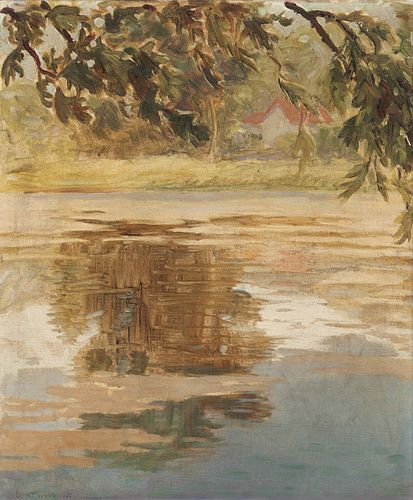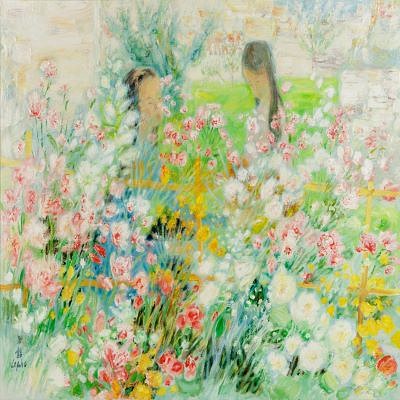Grant Wood(American, 1891-1942)Reflections, Ville d'Avray, 1920
Lot 6
About Seller
Hindman
1338 West Lake Street
Chicago, IL 60607
United States
Recognized as the Midwest's leading fine art auctioneers, Hindman Auctioneers has built a worldwide reputation based on a full service approach to the auction business tailored to meet the individual needs of our clients. Coming from a variety of educational backgrounds, specialists bring years of e...Read more
Estimate:
$15,000 - $25,000
Absentee vs Live bid
Two ways to bid:
- Leave a max absentee bid and the platform will bid on your behalf up to your maximum bid during the live auction.
- Bid live during the auction and your bids will be submitted real-time to the auctioneer.
Bid Increments
| Price | Bid Increment |
|---|---|
| $0 | $25 |
| $500 | $50 |
| $1,000 | $100 |
| $2,000 | $250 |
| $5,000 | $500 |
| $10,000 | $1,000 |
| $20,000 | $2,500 |
| $50,000 | $5,000 |
| $100,000 | $10,000 |
About Auction
By Hindman
Sep 30, 2020
Set Reminder
2020-09-30 11:00:00
2020-09-30 11:00:00
America/New_York
Bidsquare
Bidsquare : American and European Art
https://www.bidsquare.com/auctions/hindman-auctions/american-and-european-art-5534
Hindman Bidsquare@hindmanauctions.com
Hindman Bidsquare@hindmanauctions.com
- Lot Description
Grant Wood
(American, 1891-1942)
Reflections, Ville d'Avray, 1920
oil on canvas board
signed Grant Wood and dated (lower left)
15 x 13 inches.
This painting will be included in Joseph S. Czestochowski's forthcoming catalogue raisonne of the artist's work by International Arts® at www.catrais.org.
Provenance:
G. Stewart Holmes, Cedar Rapids, Iowa
James T. Holmes, son of the above, Cedar Rapids, Iowa
Exhibited:
Cedar Rapids, Iowa, Cedar Rapids Art Association, Public Library Art Gallery, Paintings of Paris by Grant Wood and Marvin D. Cone, November 10-20, 1920, no. 12, (possibly)
Lot essay:
Reflections, Ville d'Avray stands as an early work by an artistically evolving Grant Wood. Prior to developing the unique style that gave rise to such iconic works as American Gothic, Wood primarily worked in an impressionistic manner. The young Wood was part of a generation that received training when impressionism was the dominant method of painting. After studying at various Midwestern art schools, including the Art Institute of Chicago, Wood and his friend Marvin Cone traveled to France in the summer of 1920, in order to continue their studies. It was during this trip that the present artwork was created.
The pair of young artists settled in Paris, but traveled to the various suburbs surrounding the city, including Versailles and Ville d'Avray. The artist Jean-Baptiste-Camille Corot, a progenitor of impressionism, was a former resident of Ville d'Avray. Corot's home included a pond that Wood painted several times, including the present artwork and Ville d'Avray, Paris, 1920 (Cedar Rapids Museum of Art, Iowa). The two paintings were exhibited upon the artists' return from Paris in Paintings of Paris by Grant Wood and Marvin D. Cone, Public Library Art Gallery, Cedar Rapids Art Association, Cedar Rapids, Iowa, November 10-20, 1920. Cone executed a companion piece to Wood's, titled Reflections, Corot's Pond, (Cedar Rapids Museum of Art, Iowa), completed on the same June to August trip. It was on this same trip that Wood also introduced Cone to Winnifred Swift, and the two were married in 1921.
According to Cone's diary from the trip, Wood primarily worked outdoors, typically over the course of a few hours. The paintings were small for ease of transport and stylistically loose. However, Wood's meticulous temperament prevented him from fully embracing the spontaneity of impressionism. Structure and form reigned supreme for the artist, with light and color of secondary importance. This emphasis on structure can be seen in Reflections, Ville d'Avray. Strong horizontal brushstrokes delineate the reflections in the pond and divides the water and grassy bank. The close-cropped tree branches in the upper foreground partially block the distant shore with its red-roofed building, creating a sense of circumscribed privacy. It is only the free, short brushstrokes that relate the painting to impressionism and carry it closely towards abstraction. The almost decorative quality in the present work hints at the later mature style for which Wood is best known.
According to Joseph S. Czestochowski, this painting of Corot's Pond is not the Cook's Pond in Cedar Rapids, Iowa, which Darrell Garwood frequently referred to as 'Corot's Pond' in his book, Artist in Iowa, A Life of Grant Wood (New York, 1944, p. 53).
Property from the estate of Nancy Holmes, Cedar Rapids, IowaCondition
For condition inquiries please contact Mary Grace Bilby at marygracebilby@hindmanauctions.com - Shipping Info
-
Please refer to https://hindmanauctions.com/shipping-packing
-
- Buyer's Premium



 EUR
EUR CAD
CAD AUD
AUD GBP
GBP MXN
MXN HKD
HKD CNY
CNY MYR
MYR SEK
SEK SGD
SGD CHF
CHF THB
THB












